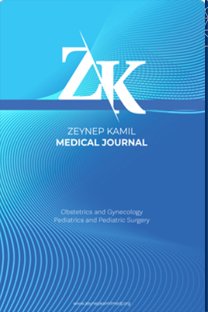Evaluation of the relationship between method of delivery and breastfeeding characteristics
Evaluation of the relationship between method of delivery and breastfeeding characteristics
___
- 1. World Health Organization. Infant and Young Child Feeding: Model Chapter for Textbooks for Medical Students and Allied Health Professionals. Geneva, Switzerland: World Health Organization; 2009. Available from: http://www.who.int/nutrition/publications/infantfeeding/9789241597494/ en.
- 2. Chung M, Raman G, Chew P, Magula N, Trikalinos T, Lau J. Breastfeeding and maternal and infant health outcomes in developed countries. Evid Rep Technol Assess (Full Rep) 2007;153(153):1–186.
- 3. Colombo L, Crippa BL, Consonni D, Bettinelli ME, Agosti V, Mangino G, et al. Breastfeeding determinants in healthy term newborns. Nutrients 2018;10(1):48.
- 4. Khooshideh M, Mirzarahimi T. The comparison of maternal and neonatal outcomes of normal vaginal delivery versus unplanned cesarean section delivery. J Ardabil Univ Med Sci 2017;17(1):122–32.
- 5. Betrán AP, Temmerman M, Kingdon C, Mohiddin A, Opiyo N, Torloni MR, et al. Interventions to reduce unnecessary caesarean sections in healthy women and babies. Lancet 2018;392(10155):1358–68.
- 6. Cavallaro FL, Cresswell JA, Ronsmans C. Obstetricians’ opinions of the optimal caesarean rate: A global survey. PLoS One 2016;11(3):e0152779.
- 7. Betrán AP, Ye J, Moller AB, Zhang J, Gülmezoglu AM, Torloni MR. The increasing trend in caesarean section rates: Global, regional and national estimates: 1990-2014. PLoS One 2016;11(2):e0148343.
- 8. Boerma T, Ronsmans C, Melesse DY, Barros AJ, Barros FC, Juan L, et al. Global epidemiology of use of and disparities in caesarean sections. Lancet 2018;392(10155):1341–8.
- 9. Prior E, Santhakumaran S, Gale C, Philipps LH, Modi N, Hyde MJ. Breastfeeding after cesarean delivery: A systematic review and meta-analysis of world literature. Am J Clin Nutr 2012;95(5):1113–35.
- 10. Ip WY, Gao LL, Choi KC, Chau JP, Xiao Y. The short form of the breastfeeding self-efficacy scale as a prognostic factor of exclusive breastfeeding among mandarin-speaking Chinese mothers. J Hum Lact 2016;32(4):711–20.
- 11. Yakar B, Karaca AA, Tanriöver Ö. Emziren annelerin ilk 6 ay sadece anne sütü verme oranlari ve etkileyen faktörlerin araştırılması. Firat Med J 2020;25(4):195–202.
- 12. Centers for Disease Control and Prevention. Breastfeeding Report Card: United States; 2020. Available from: https://www.cdc.gov/breastfeeding/ data/reportcard.htm.
- 13. Centers for Disease Control and Prevention. Breastfeeding Report Card: United States; 2016. Available from: https://www.cdc.gov/breastfeeding/ pdf/2016breastfeedingreportcard.pdf.
- 14. Centers for Disease Control and Prevention. Breastfeeding Report Card: United States; 2018. Available from: https://www.cdc.gov/breastfeeding/ pdf/2018breastfeedingreportcard.pdf.
- 15. Hüray K, Şenol E, Keskindemirci G, Selver MB, Gökçay G. Bir çocuk sağliği izlem polikliniğinde 4. Ve 6. Ay sadece anne sütü ile beslenme oranlari ve anne eğitim düzeyi-ön çalişma sonuçlari. Çocuk Dergisi 2020;20(2):43–7.
- 16. Zanardo V, Svegliado G, Cavallin F, Giustardi A, Cosmi E, Litta P, et al. Elective cesarean delivery: Does it have a negative effect on breastfeeding? Birth 2010;37(4):275–9.
- 17. Guala A, Boscardini L, Visentin R, Angellotti P, Grugni L, Barbaglia M, et al. Skin-to-skin contact in cesarean birth and duration of breastfeeding: A cohort study. ScientificWorldJournal 2017;2017:1940756.
- 18. Zhao J, Zhao Y, Du M, Binns CW, Lee AH. Does caesarean section affect breastfeeding practices in China? A systematic review and meta-analysis. Matern Child Health J 2017;21(11):2008–24.
- 19. Rowe-Murray HJ, Fisher JR. Baby friendly hospital practices: Cesarean section is a persistent barrier to early initiation of breastfeeding. Birth 2002;29(2):124–31.
- 20. Taha Z, Ali Hassan A, Wikkeling-Scott L, Papandreou D. Prevalence and associated factors of caesarean section and its impact on early initiation of breastfeeding in Abu Dhabi, United Arab Emirates. Nutrients 2019;11(11):2723.
- 21. NEOVITA Study Group. Timing of initiation, patterns of breastfeeding, and infant survival: Prospective analysis of pooled data from three randomised trials. Lancet Glob Health 2016;4(4):e266–75.
- 22. Yisma E, Mol BW, Lynch JW, Smithers LG. Impact of caesarean section on breastfeeding indicators: Within-country and meta-analyses of nationally representative data from 33 countries in Sub-Saharan Africa. BMJ Open 2019;9(9):e027497.
- 23. Cisco J. Who supports breastfeeding mothers?: An investigation of kin investment in the United States. Hum Nat 2017;28(2):231–53.
- 24. Dewey KG, Nommsen-Rivers LA, Heinig MJ, Cohen RJ. Risk factors for suboptimal infant breastfeeding behavior, delayed onset of lactation, and excess neonatal weight loss. Pediatrics 2003;112(3):607– 19.
- ISSN: 1300-7971
- Yayın Aralığı: Yılda 4 Sayı
- Yayıncı: Ali Cangül
Ebru ÇÖĞENDEZ, Önder TOSUN, Mahmut ERDEMOĞLU
Bilateral serous macular detachment as a complication of preeclampsia: A case report
Özkan KOCAMIŞ, Emine TEMEL, Kemal ÖRNEK, Nazife Aşıkgarip
Acute dystonia after domperidone use: A rare and an unexpected side effect
Salih DEMİRHAN, Özlem ERDEDE, Rabia Gönül SEZER YAMANEL
Oncologic breast surgery of retroareolar breast cancer with racquet mammoplasty technique
Semih BOLU, Fatih İŞLEYEN, Ayşegül DANIŞ
Evaluation of the relationship between method of delivery and breastfeeding characteristics
Selcuk UZUNER, Feyza USTABAŞ KAHRAMAN, Beyza MAŞLAK
PET/CT dilemma in para-aortic lymph node assessment in locally advanced cervical cancer?
Tayup ŞİMŞEK, Selen DOĞAN, Özer BİRGE, Mehmet Sait BAKIR, Hasan Aykut TUNCER, Ceyda KARADAĞ
Hasan Hüseyin MUTLU, Elif YÜKSEL KARATOPRAK, Müferet ERGÜVEN, Nilüfer ÇETİNER
